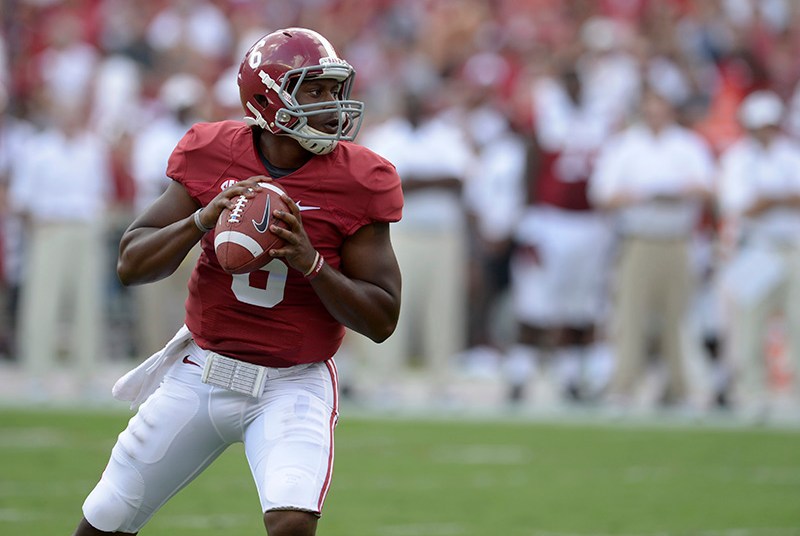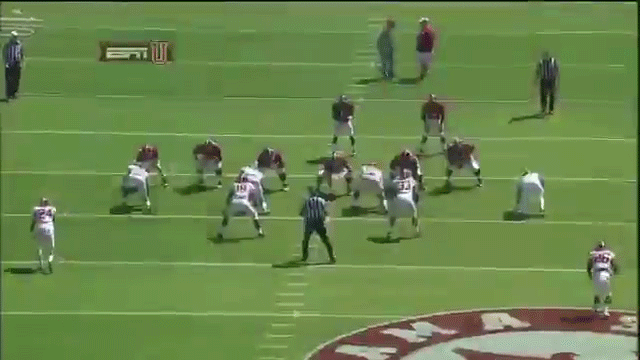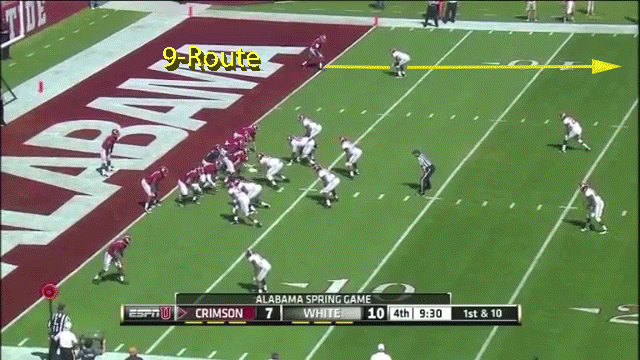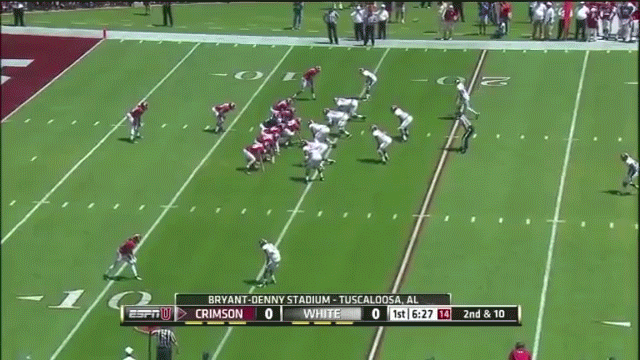Film study: Examining how Alabama's offense may look with Sims at QB
Let’s be honest here; all of us believed it was a foregone conclusion that Florida State transfer Jacob Coker would get the nod to start at quarterback for the Alabama Crimson Tide this season. Many of us scoffed at the notion that fifth-year senior Blake Sims would even have a fair chance to supplant the greatest QB in the program’s history, A.J. McCarron.
After all, Coker appears to be the better fit for new offensive coordinator Lane Kiffin’s precise, rhythm-and-timing-based West Coast system.
But either head coach Nick Saban deserves an Emmy for his acting ability in press conferences, or Sims may have had more of a chance than we initially thought, because there’s a perceived groundswell of momentum building for the Gainesville native.
Either way, we may have to wrap our collective brains around how the offense may look with Sims at the helm.
Sounds funny, doesn’t it?
– – – – – – –
Under former coordinator Doug Nussmeier, the Tide ran a pro-style, spread-based, zone-equipped attack predicated on play-action fakes. The run game was predominantly single back with those aforementioned zone principles.
Kiffin’s West Coast system will be predominantly based out of pro-sets with a lot of “21” and “22 personnel.” Fullback Jalston Fowler will have a more significant role, as will tight end O.J. Howard. We should also expect a mix of man- and zone-blocking principles.
Additionally, the scheme is versatile enough to account for athleticism at the quarterback position, which something we are seeing develop right in front of us, personnel wise.
The Blake Barnett Effect
The signing of the No. 1-ranked dual-threat QB (depending on the recruiting service) may have signaled a change in philosophy at the Capstone. Now some may argue that it was a forced reversal of trends — after the decommitment of top-ranked pro-style QB Ricky Town — but sometimes the most effective changes are developed out of necessity.
And after key losses to offenses with dual-threat signal-callers, most notably to Auburn and Texas A&M, evolving the offense can only of benefit to the Tide.
But make no mistake about it; the signal-caller will still have to be able to make plays from the pocket. And that’s something that Sims will have to improve upon if called to lead Bama.
The A-Day Debacle
The word coming out of Tuscaloosa during the spring was that Sims was looking every bit the starter during practices. But things quickly unraveled for the senior during the annual spring game — which was a fact that was not lost on Saban.
“Blake had a really good spring and did a really good job in the scrimmages,” Saban told reporters after the game (h/t to Russell Westerholm of the University Herald)”I thought… the game speeded up today and he tried to speed up with it, rather than just staying in his rhythm.”
And here’s a shining example of that:
Here we see Sims working with a delayed inside screen. The object of the play is to get the weak-side defensive end penetrating upfield and slip the screen right by him. To play devil’s advocate, freshman left tackle Cam Robinson released too early — barely engaging the end.
But regardless, it’s Sims’ responsibility to survey the entire scene before making any decision. We’ve seen McCarron throws screens like this in the dirt because the play had been blown up.
This was a prime example of the game moving too fast for Sims.
Here Sims played this 9-route about as elementary as one can. Despite having the benefit of being able to attempt an explosive pass on first down, Sims chose to not look off his key — the free safety — instead opting to stare down his primary target.
It’s fine to already have a target in mind, actually sometimes it works to your benefit, but looking at a secondary target will only shift focus away from your primary. Thus working in your benefit.
Had Sims froze the safety even a millisecond, he would’ve ensured one-on-one coverage with his speedy receiver Christion Jones. It’s the nuances of the position that Sims must also improve upon. But he’s definitely talented enough to make the necessary changes.
The Move-The-Pocket Game
Not all was wrong for Sims during A-day. We got a glimpse of him performing a ton of bootlegs and sprint-options — which are staples in Kiffin’s West Coast systems. The benefits you get from forcing a defense to defend the entire field is exponential.
You can help a mobile QB out by cutting down on his reads and progressions in the move-the-pocket game. Eventually a QB will need to be able to work from within the pocket. But rolling a QB out can ease the transition, and most importantly it can help move the chains.
But decidedly it gives the offense an advantage where the normal pocket-passer wouldn’t have one.
Here is Sims on a sprint-option. With the slot receiver running a clearout route, it leaves Sims with a single read on the “field” side of the formation. The decision to either run or pass has to be made by the time the receiver comes out of his curl — unless he works his way back to the ball. Sims didn’t like what he saw, so he kept it and still make a positive gain to stay ahead of the chains.
Here’s where the combination of Bama’s run game and Sims’ mobility would be downright frightening. With backs like T.J. Yeldon, Kenyan Drake and Derrick Henry defenses have no choice but to show the utmost respect to anything remotely resembling a handoff.
But with Sims’ ability to run as well, it will freeze linebackers and open things up downfield. With Kiffin’s use of pro-sets, and having a do-it-all monster like Fowler at fullback, the short-to-intermediate game has a chance to be a legit chain mover for the Tide.
Here Fowler catches the ball and gets north/south for a first down. Not many linebackers or defensive backs will want to get in the way of the 6’1″, 250-pound Fowler in the open field.
And with a receiving corps that consists of Amari Cooper, DeAndrew White, Chris Black and Robert Foster, to go along with most possibly the most athletic tight end football in Howard, most Bama QBs should be able to make plays through the air.
If the offense is undergoing an evolution of sorts, starting Sims might not be a bad idea. He has a strong arm and brings a dynamic to the position we haven’t seen in recent memory.
But by most accounts (including your’s truly), Coker remains the most talented QB on the roster and would bring a ton of intangibles to the table as well. Not to mention he’s a really good athlete, although not quite to the degree of Sims, with ideal size for the position (6’5″, 230 lbs).
No matter which way the staff goes, the athletes at the skill positions — combined with that ferocious defense — will make Bama a major player in the national title picture. But Saban wants you to know the QB picture remains unsettled, and he also wants you to know not to count out Sims.
“No one ever seems to ask about Blake Sims,” Saban said in response to a question about Florida State transfer Jacob Coker (h/t to Graham Watson of Yahoo! Sports). “But he has done extremely well so far in camp as well.”
Duly noted, Coach Saban…





